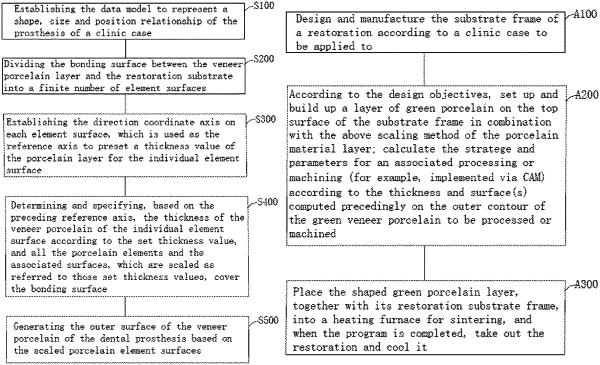| CPC A61C 13/0004 (2013.01) [A61C 5/77 (2017.02); A61C 13/0022 (2013.01); A61C 13/081 (2013.01); B33Y 10/00 (2014.12); B33Y 40/20 (2020.01); G06F 30/10 (2020.01)] | 7 Claims |

|
1. A method for scaling a veneer porcelain layer of a restoration, wherein the method comprises:
step S100, establishing a data model to represent a shape, size and position relationship of the restoration;
step S200, dividing a digital representation of a bonding surface formed between the veneer porcelain layer and a restoration substrate into a limited number of element surfaces;
step S300, establishing a direction coordinate axis on each of the element surfaces, which is used as a reference axis for setting a thickness value of the veneer porcelain layer for the element surfaces individually;
wherein the direction coordinate axis is established on each of the element surfaces and set perpendicular to the element surfaces individually, each of the element surfaces is used as an independent scaling zone, a scaling size of the thickness value of the veneer porcelain layer in each of the scaling zones is set independently according to sintering conditions or positions of the scaling zones on the bonding surface;
step S400, determining and specifying, based on the reference axis, a thickness of the veneer porcelain layer based on the element surfaces individually on the bonding surface according to the thickness value, and all of the element surfaces, which are scaled according to the thickness values, cover the bonding surface;
wherein in a case where a preset thickness value for every one of the element surfaces is equal, an outer profile of the veneer porcelain layer for the restoration is directly generated based on all the element surfaces after being scaled, in a case where the preset thickness values are not equal, an inter-surface fitting among vicinal areas between every two adjacent element surfaces of the element surfaces by utilizing a smooth algorithm, spline interpolation, gradient approach or weighted mean, for uneven connections throughout the element surfaces, such that a smooth curved interface between the every two adjacent element surfaces is produced, and an outline surface of the veneer porcelain layer for the restoration is shaped up together with the method for scaling and the smooth algorithm;
wherein the smooth algorithm to generate the inter-surface fitting among the vicinal areas between the every two adjacent element surfaces comprises: setting up at least one boundary line on an interface between the every two adjacent element surfaces with a series of preset weight values, and with such a boundary line as a reference, setting up constraint conditions for smooth inter-surface fitting among the vicinal areas between the every two adjacent element surfaces; and
step S500, generating an outer surface of the veneer porcelain layer of the restoration based on the element surfaces after being scaled.
|